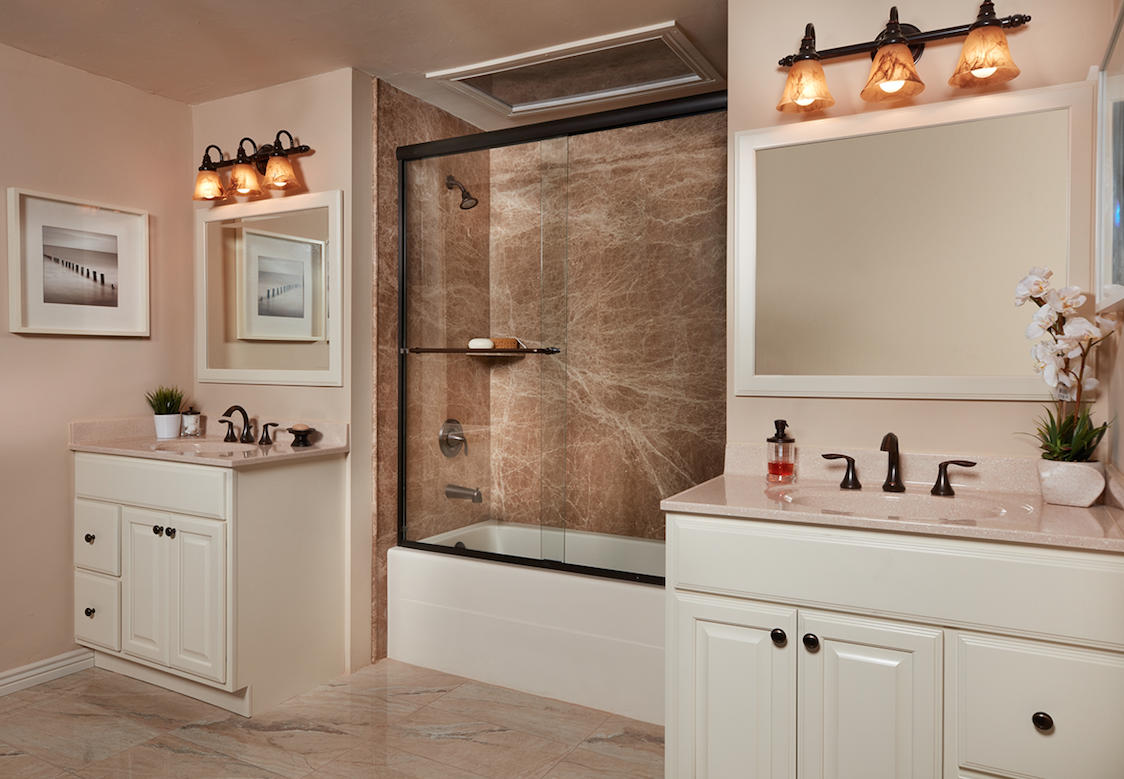Hotel guests expect bathrooms to have a fresh and modern look. Old, dated or damaged bathtubs, wall-surrounds, vanities or toilets reflect poorly on the hotel’s brand. As such, many hotels regularly replace bathroom components to maintain customer satisfaction and earn positive reviews and loyalty in return.
But remodeling hotel bathrooms is not as simple as hiring a general contractor that subcontracts the work to a local crew. There are many industry-specific considerations that are best served by those who already have extensive experience working with other hotel chains.
These concerns include reducing or eliminating construction noise, odors or dirt/dust that can disrupt other guests. The work must be completed within budget and as quickly as possible to return rooms to service.
In addition, there are economies of scale. Because renovation is typically completed in blocks of rooms, installers that regularly service the hospitality industry can often provide better pricing on items—for example, acrylic bathtub liners—than those that primarily serve the residential home market.
“There are local companies that I can call right now where an acrylic bathtub liner may cost me $1,000,” said James Rutherford, chief engineer at the Hilton Cincinnati Netherland Plaza. “But I can get one shipped from one of the more established companies for half that price.”
There are other potential benefits as well. Hotel-specific providers are often already certified to work with existing chains and tend to keep specifications of commonly installed items on file.
“There are quite a few reasons to go with a company that already knows the industry, understands our concerns and can complete the work quickly and quietly,” Rutherford said.

Bathtubs: Replace, Refinish or Reline
When it comes to updating a worn-out bathtub, three options are available, all varying in cost, labor and potential for guest disturbance: replacing, refinishing and relining.
Replacing an old bathtub is an expensive, labor-intensive and time-consuming project that often involves demolition and damage to the surrounding walls and floor finishes. Water supply lines and pipes may also need re-plumbing.
For a historic hotel, Rutherford said, bathtub replacement is rarely an option. “We wouldn’t consider ripping out the tub unless we were doing a full renovation of the room because our walls have the original tiles. Replacing the walls is just not cost effective because of the rebuilding cost,” he said.
In addition, replacing a bathtub can take several days and can be extremely noisy and dusty, often leading to complaints from guests.
A second option involves the refinishing, or re-glazing, of the existing bathtub. The process includes sanding the current coating, filling chips with epoxy, followed by coating and polishing. While this option costs less than a full replacement, it can take several days to complete, and Rutherford said that although re-glazed bathtubs look beautiful, the finish only lasts a few years.
Odors released during application are another factor to consider. “You’ve got to block rooms and take them out of your inventory. Even though you go through all the proper processes and ventilation, the smell lasts for several days,” Rutherford said.
The third option is to use an acrylic bathtub liner installed on top of the existing bathtub—creating a new bathtub surface that can last for decades. Made from durable materials, acrylic bathtub liners have high gloss, minimal porosity and excellent scratch resistance—all of which simplifies cleaning.
Installation is a critical aspect with any acrylic bathtub liner. Some manufacturers, such as American Bath Remodeling, have developed proprietary and patented installation process to ensure a complete, watertight fit. Because the acrylic bathtub liner comes pre-fitted, installation takes less than two hours. With no drying time required, the bathtub can be used almost immediately after installation. Of all the options, relining a bathtub is the least disruptive and does not affect overnight room availability.
Wall-Surrounds
Wall surrounds are another remodeling option. Manufactured from non-porous and stain resistant DuraBath SSP, cultured marble and even granite, wall-surrounds are available in many color and pattern options. Installed over existing walls, including tile, this is an excellent option for swift installation with little down time or guest interruption.
Dick Patel, owner of the Days Inn, in Niles, Ohio, selected wall surrounds for a major bathroom remodel he embarked on shortly after acquiring the property. The installers completed 10 rooms a day, for a total of 80 rooms, and did not affect overnight room availability. Patel expected the wall surrounds to last 15 years, but now, almost 30 years later, he says they still look like new.
“The walls are easy to keep clean and don’t require abrasives,” said Patel. “The original shine is still there.”
Before starting any remodeling project, Patel recommends that hotel operators ask others for references and inquire about how much they like the products and the installer. When possible, a visit to look at remodeled bathrooms is also beneficial.
As with any renovation project, bathroom remodeling requires thorough planning, as well as selecting a reputable contractor with extensive experience in the hospitality industry. Hotel operators need to take into consideration the scope of the work involved and the many options available for materials and components, while adhering to budget limits, minimizing guest disturbance and maximizing daily room availability.
Dave Sanders is president & CEO of American Bath Remodeling and has over 35 years of expertise in commercial remodeling. American Bath Remodeling is a one-stop, commercial bathroom remodeler that includes all manufacturing, installation and service of bathtub liners, wall surrounds and vanities. The company was founded in 1979.
